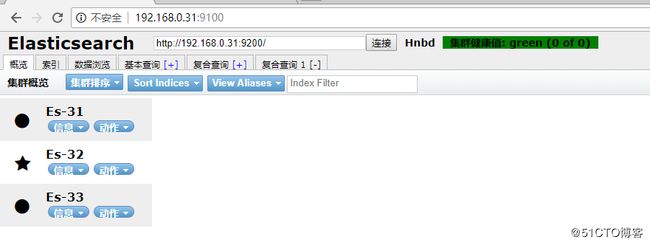操作系统版本:centos 7.6
版本:elasticsearch 7.6.1
jdk版本 11.0.6
服务器列表:
192.168.0.31
192.168.0.32
192.168.0.33
1、安装jdk 11
具体的步骤省略
2、安装elasticsearch
官网下载elasticsearch-7.6.1-x86_64 rpm安装包
rpm -ivh elasticsearch-7.6.1-x86_64.rpm
修改配置文件
#cat /etc/elasticsearch/elasticsearch.yml |grep -v "^#"
cluster.name: Hnbd#集群名称
node.name: Es-31#集群节点名称
path.data: /var/lib/elasticsearch#数据文件路径
path.logs: /var/log/elasticsearch#日志文件路径
bootstrap.memory_lock: true#锁定物理内存地址,防止elasticsearch内存被交换出去,也就是避免es使用swap交换分区
network.host: 0.0.0.0#ip地址
http.port: 9200#开放端口号
discovery.seed_hosts: ["192.168.0.31","192.168.0.32", "192.168.0.33"]#设置集群节点地址
cluster.initial_master_nodes: ["Es-31"]#指定主节点列表
http.cors.enabled: true#打开跨域访问,head 插件需要这打开这两个配置
http.cors.allow-origin: "*"
添加开机服务启动
systemctl enable elasticsearch.service
设置JVM堆内存大小,根据服务器内存大小进行设置,最好不要超过总内存的一半
#cat /etc/elasticsearch/jvm.options
## JVM configuration
# Xms represents the initial size of total heap space
# Xmx represents the maximum size of total heap space
-Xms2g
-Xmx2g
设置elasticsearch的JAVA_HOME
#cat /etc/sysconfig/elasticsearch |grep "JAVA_HOME"
JAVA_HOME=/usr/java/jdk-11.0.6/
centos7需要修改systemd配置,否则启动会报错
/etc/systemd/system.conf
DefaultLimitNOFILE=65536
DefaultLimitNPROC=32000
DefaultLimitMEMLOCK=infinity
ERROR: bootstrap checks failed memory locking requested for elasticsearch process but memory is not locked
官网说明:
elasticsearch官网建议生产环境需要设置bootstrap.memory_lock: true
官网的解释
是:发生系统swapping的时候ES节点的性能会非常差,也会影响节点的稳定性。所以要不惜一切代价来避免swapping。swapping会导致Java GC的周期延迟从毫秒级恶化到分钟,更严重的是会引起节点响应延迟甚至脱离集群。所以最好限制住elasticsearch占用的内存情况,可选少用swap
centos7需要修改systemd配置,centos6方式不一样
3、安装elasticsearch-head插件
elasticsearch 7.6是需要单独安装这个插件的,之前的老版本自带插件
安装依赖包
yum install curl-devel expat-devel gettext-devel openssl-devel zlib-devel asciidoc xmlto docbook2X gcc-c++ autoconf bzip2 -y
cd /usr/local/src/
使用git获取源码包
git clone https://github.com/mobz/elasticsearch-head.git
安装nodejs
curl -sL https://rpm.nodesource.com/setup_10.x | bash -
yum install -y nodejs
#node -v
v10.19.0
#npm -v
6.13.4
安装grunt客户端程序来控制head插件
npm install -g grunt --registry=https://registry.npm.taobao.org
npm install -g grunt-cli --registry=https://registry.npm.taobao.org
npm install grunt-contrib-clean --registry=https://registry.npm.taobao.org
npm install grunt-contrib-concat --registry=https://registry.npm.taobao.org
npm install grunt-contrib-watch --registry=https://registry.npm.taobao.org
npm install grunt-contrib-connect --registry=https://registry.npm.taobao.org
npm install grunt-contrib-copy --registry=https://registry.npm.taobao.org
npm install grunt-contrib-jasmine --registry=https://registry.npm.taobao.org
修改Gruntfile.js配置文件,添加hostname字段
connect: {
server: {
options: {
port: 9100,
hostname: "*",
base: '.',
keepalive: true
}
}
}
修改/usr/local/elasticsearch-head/_site/app.js默认端口号把9200改为9100,此端口是head对外提供的http端口,把localhost改为本机对外访问的地址
this.base_uri = this.config.base_uri || this.prefs.get("app-base_uri") || "http://192.168.0.31:9100";
注:前边的elasticsearch.yml配置文件一定要打开跨域访问配置文件(http.cors.enabled: true http.cors.allow-origin: "*")
启动elasticsearch-head
#cd /usr/local/elasticsearch-head
#nohup grunt server &
浏览器打开elasticsearch-head
http://192.168.0.31:9100/
